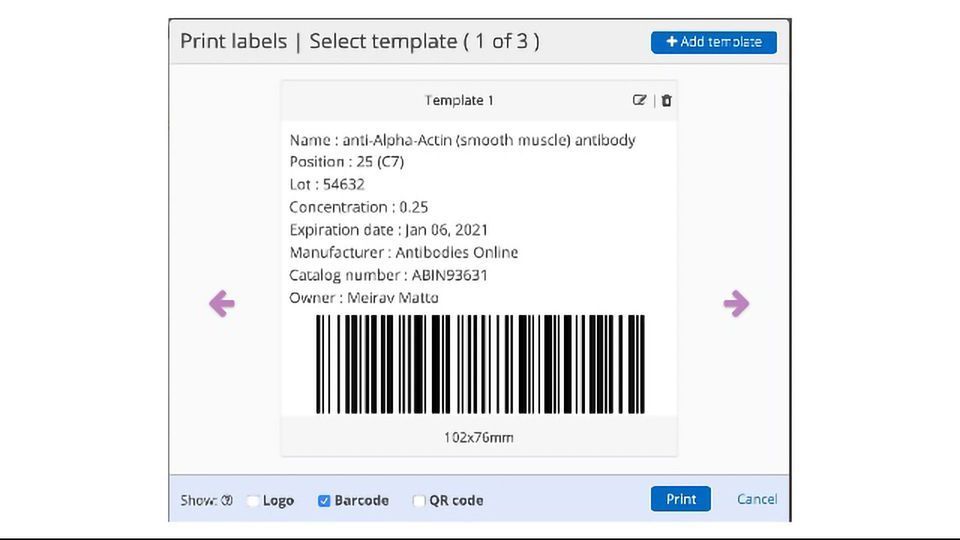The End of the Error – How Barcode Systems Are Improving Efficiency in Labs

Complete the form below to unlock access to ALL audio articles.
A key challenge facing biotechnology and pharmaceutical laboratories is how they can reduce mislabeling errors, which can be difficult to spot and have a huge impact on a research project. Laboratories that rely on manual sample labeling can suffer from a high rate of human error. It is all too easy for employees to invert numbers, skip a line, misread a number, or use poor handwriting that others cannot read when labeling or tracking samples manually.
In fact, on average, people make an error in one out of every 300 characters they write, resulting in an average of 18 mistakes per hour (1). Barcode labeling reduces the likelihood of human error and allows lab staff to spend more time focused on their research.
Barcode labeling is one of the simplest ways to achieve both cost reduction and increased efficiency in the lab. This article looks at how barcode labeling systems, combined with a good laboratory inventory management system, improve data collection and management, help streamline inventory management and decrease human errors, while enhancing collaboration.
Effective barcode labeling
One of the main advantages of using a barcode labeling system in a lab is that it simplifies the process of tracking the correct samples and types of equipment needed to perform experiments. Whether a project involves a few or thousands of samples, tracking them by barcode accelerates the process and eliminates mistakes that can be costly and time consuming (2). Employees using barcode systems also work much more quickly than employees who rely on manual data entry, with studies finding that barcode use results in an eight to ten-fold increase in productivity in a lab setting (3).
Running an inventory with barcodes enables employees to locate samples faster and access all the relevant information such as price and supplier. This, along with real-time inventory monitoring and updating, results in greater efficiency as it allows better management of inventory purchases.
Data sharing and collaboration
Samples are often used in several experiments by different members of the team and can even be shared with other collaborators within the laboratory. Barcoding helps researchers collaborate without interfering in each other’s work by marking finished samples as completed and avoiding misplacement, all of which results in a more organized lab.
The US Geological Society has addressed the problem of working on large data sets across several different lab locations by introducing barcodes into their workflow. They did this by collating the sample and storage location information associated with a large sample library.
This has resulted in greater efficiencies within the lab when analyzing fieldwork collected over a period of time, as all research data is collated and stored in a single location, making it easier to analyze changes over time. It also means samples and results can be replicated in labs in different locations, making projects more efficient and cost effective (4).
Reproducibility
Successfully reproducing experiments is a central issue in most research projects. There is a lot of work being done to reproduce published experiments. However, according to a survey published in the journal Nature, more than 70% of researchers have tried and failed to reproduce another scientist's experiments (5).
This is a major issue facing the scientific community as the ability to accurately reproduce experiments is a fundamental element of research and development within a lab (6). Sample barcode scanning helps to increase reproducibility, improving efficiencies within a lab. By ensuring there is an accurate list of the samples used during an experiment, including all the associated research information, it is easier to reproduce the results.
Applying barcode scanning with a good laboratory inventory management system can help achieve fuller and more accurate information, as all the data is linked and saved in one place.
Using barcode systems with an ELN for maximum efficiency
To use a barcoding system in a lab you also need to have an effective Electronic Lab Notebook (ELN) with an inventory management system in place. The combination of barcoding and ELN helps further improve efficiencies by allowing data to be collected and shared across multiple labs in real time. This reduces the need to rely on manual data entry as well as allowing labs in different locations to confidently share accurate data.
For many labs, an effective barcode labeling system is now an essential tool which makes research and development more efficient than ever. Changes in technology mean these systems are more affordable than ever and the benefits can be enjoyed by large and small labs alike.
To learn more about Labguru, BioData’s cloud-based lab management solutions, visit www.labguru.com.
References:
1. Information systems and human error in the lab - https://www.ncbi.nlm.nih.gov/pubmed/15597557
2. Effectiveness of Barcoding for Reducing Patient Specimen and Laboratory Testing Identification Errors: A Laboratory Medicine Best Practices Systematic Review and Meta-Analysis - https://www.ncbi.nlm.nih.gov/pmc/articles/PMC4518452/
3. How Barcodes Work to Increase Efficiency: Reducing Human Error, Optimizing Data Entry, and More - https://www.mpofcinci.com/blog/how-barcodes-increase-efficiency/
4. Barcodes Are a Useful Tool for Labeling and Tracking Ecological Samples - https://esajournals.onlinelibrary.wiley.com/doi/full/10.1890/0012-9623-95.3.293
5. 1,500 scientists lift the lid on reproducibility - Nature - https://www.nature.com/news/1-500-scientists-lift-the-lid-on-reproducibility-1.19970
6. Most scientists 'can't replicate studies by their peers' – BBC News https://www.bbc.co.uk/news/science-environment-39054778
About the author:
Steve Yemm is CEO at BioData, a Digital Science company providing lab informatics products—including Electronic Lab Notebook, Lab Inventory, Chemical Registration and Biological Screening solutions—to biopharmaceutical and academic life sciences organizations in addition to other science-based industries. The company’s solutions are powered by Labguru, a web- and cloud-based informatics platform. Prior to this, Steve held the position of Vice President of Sales at BioData and Digital Science and has over 20 years of experience selling and marketing solutions (software, services and automation systems) to science-based companies.


